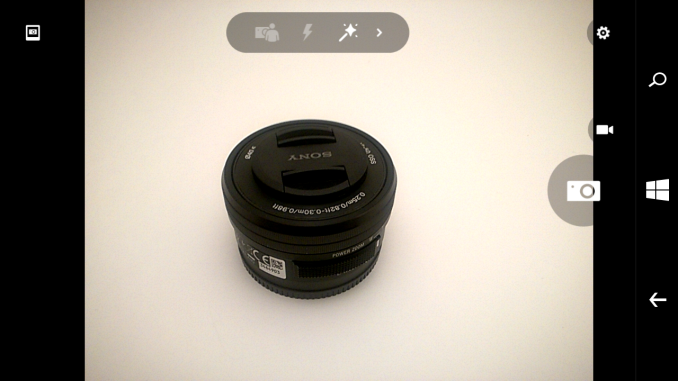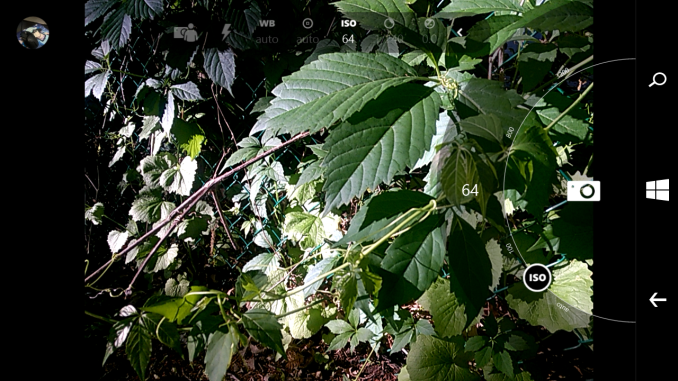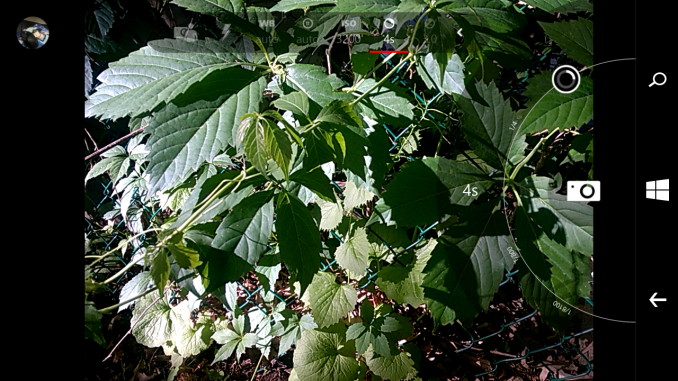The Microsoft Lumia 640 Review
by Brandon Chester on June 9, 2015 8:00 AM EST- Posted in
- Smartphones
- Microsoft
- Mobile
- Lumia
- windows phone 8
Camera Architecture
Due to the more closed nature of Windows Phone, I can’t do much poking around to find detailed information on the cameras in the Lumia 640. The information that I have been able to collect is organized in the chart below. The main omission is the sensor manufacturer, which I would suspect is Omnivison or Toshiba, but I can’t say for sure exactly what it is.
| Microsoft Lumia 640 Cameras | ||||
| Front Camera - Resolution | 0.9MP (1280x720) | |||
| Front Camera - Focal Length | 1.5mm (30mm eff) | |||
| Front Camera - Aperture | F/2.4 | |||
| Rear Camera - Resolution | 8MP (3264x2448) | |||
| Rear Camera - Sensor Size | 1/4", 1.12µm pixels | |||
| Rear Camera - Focal Length | 3.0mm (28mm eff) | |||
| Rear Camera - Aperture | F/2.0 | |||
On paper, the Lumia 640’s camera hardware is better than a lot of other devices at this price point. I recently reviewed the 2015 Moto E, and on paper the Lumia 640 has higher resolution cameras with larger sensors on the front and back, and the front camera has a significantly wider aperture. While the specifications of the camera sensor and lens aperture hardly tell the whole story when it comes to image quality, they definitely put the Lumia 640 in a better position when it comes to sharpness and low light performance.


The focus time on the Lumia 640 sits right in the middle of our comparison results. It’s slightly faster than many other devices that don’t have PDAF or laser based autofocus, but it’s not as fast as phones like the Nexus 6, and not near as fast as the iPhone 6 and Galaxy S6 with their PDAF. Shot latency is also right around the middle, and while there is a tiny bit of a delay between shots, I never felt like I was kept waiting for an unreasonable time when trying to take several photos quickly.
Camera UX
A device’s camera application has a big impact on the user’s experience when taking photos or shooting video. If the camera preview is cropped or badly scaled then it’s difficult for the user to gauge what their photos will look like. A high resolution preview and an accurate aspect ratio are necessary to frame and compose photos properly. For quite some time I’ve heard great praise for the Lumia camera application interface and the manual controls that it offers, so I was excited to have a chance to try it in depth.
Upon first opening the Lumia Camera app, I felt like the interface was fairly organized and well laid out. It was immediately obvious that tapping the right-facing arrow in the menu at the top would reveal more controls, and that hitting the gear in the upper right would show me options. Having a button to instantly record video is also very handy. The camera preview would definitely be improved if it were higher resolution, but this is mostly a limitation of the ISP so there's not much that can be done.
Once I started trying to use the manual controls I was very happy that the app uses what is basically a dial interface to make adjustments. It reminds me a lot of the control dials on a real camera, which is a good design decision, as anyone interested in these controls probably has prior experience with photography.
Unfortunately, I very quickly ran into a number of issues with the manual controls on the Lumia 640. The first problem was that I seemingly could only adjust one option at a time. While this is a common limitation of smartphone camera interfaces, it was very annoying because you had to continually move your thumb between the control wheel and the menu at the top. This is a much less ergonomic and more time consuming method of adjustment than something like ASUS’s camera interface where the menu for selecting each control and the menu for performing adjustments are beside each other.
After asking people who were more familiar with Windows Phone, I was told that you can pull outwards on the shutter button to bring up every control at once. I have two issues with this gesture. The first is that it’s not obvious at all. The only way I was able to find it was because I was told by another person, and that alone is a pretty massive design failure. My other issue is that it doesn’t directly solve my problem. I want the settings and the menu for adjusting them to be adjacent, not a giant menu of controls covering up the camera preview.
The fact that you wouldn’t be able to see the changes you’re making reflected in the preview because it’s covered by semi-opaque menus would be a big issue if it weren’t for an even bigger problem with the Lumia Camera application. The biggest issue of all is that camera preview does not change to reflect adjustments to ISO and shutter speed. At first, I had assumed my device was suffering from a bug, but after doing some troubleshooting I asked our editor Brett Howse to confirm that his Windows Phones behaved the same way. When he confirmed that they did I really didn’t know what to say. Having manual camera controls that aren’t reflected in the camera preview makes them essentially unusable. While changes to white balance, brightness, and focus do show up in the preview, your adjustments to ISO and shutter speed do not. This means that you have no visual idea of what the exposure of your photo is going to be.
I wasn’t near as impressed with the Lumia Camera application as I had expected to be based on what I had heard about how camera-centric Lumia devices are. While the interface for auto mode is fine, it’s basically impossible to mess that up unless you're trying to. The manual controls aren’t implemented in a very obvious and accessible manner, and the most important ones require you to just pray that the exposure meter is accurate, which ruins the entire concept of having full control over how your photos turn out.














130 Comments
View All Comments
gwydionjhr - Tuesday, June 9, 2015 - link
For the kind of user that is buying a $129 smartphone I think Microsoft has put it's priorities in the right place, a good camera and a screen that is readable in all conditions are things that any user will appreciate. I've helped dozens and dozens of normal users with all types of smartphones and I can only shake my head at the number of people paying $70mth to use a $700+ plus device that they only use for texting, email, FB and phone calls.cjs150 - Tuesday, June 9, 2015 - link
This is a cheap phone.It lasts most of a day between charges (not really good enough). It has a decent camera, decent display and presumably syncs really well with MS Outlook (if not what are MS doing!).
Is it slow - yes
Will it run the very latest apps - no.
Is it good enough for 90% of market aged more than 25 - yes. Ultimately on a tech website we forget that most people do not need most of the features. Checking emails, using maps/navigation and the ability to check social media is good enough
Very tempted - but for the battery life
MonkeyPaw - Tuesday, June 9, 2015 - link
And for all the bagging people are doing on MS for pushing out cheap phones, the strategy has really helped MS gain share outside of US/Europe. India, with its billions of people, might actually be a market to get into, no?Sure, we want premium phones here, but the 1520 and 930 are by no means junk, even this long past launch.
That said, it's a shame WP coverage at Anandtech is so thin. Never reviewed the 1020. Never reviewed the 1520. But hey, let's review the cheap MS phones and then make conclusions about the ecosystem. It's been the problem MS has had all along--solid efforts and unique offerings are essentially shunned by the community. We need more than Apple and Google in this space.
AEGorenberg - Tuesday, June 9, 2015 - link
I have this phone (changed from Note 2 on Sprint) and get an astonishing 2.5 to 3 days on a charge -- with light to moderate use. Also, no dropped calls in the 2 weeks I have owned it. For $129, it works great and I don't even worry about scratches on the case or having to protect it. The main drawback is that the Windows Phone iteration of popular apps are terrible (like Words with Friends).tdrroc - Tuesday, June 9, 2015 - link
I second this comment... I have a 635 - predecessor to this phone - and I can go multiple days without charging. I use GPS for directions and exercise, wifi and LTE antennae for streaming and web access. When I compare my battery life for WP with what I experienced with Android (on a Nexus 4 even)...it's no comparison. WP blows it out of the water. I have a charging cable I bought for my car...never use it.leexgx - Friday, June 12, 2015 - link
i do find windows and blackberry phones Very reliable for LTE and calls (GSM phone)blackberry Q10 i got here if it gets a wiff of 4G (real 4G>LTE for USA peeps) it will use it until it gets to low then drops to 3G (where as android phones just drop when signal is at 20-30% still)
quite sure the windows phone does the same thing it fast changes to LTE if available (but on EE UK 4G is bit Iffy at work and makes phone calls bugger up when you answer the phone, this is network issue not the phone, so tend to leave that phone on 3G max speed)
compared to the android phones i got its like i got New 4G masts installed in my area,, same network in an android phone i have to set it to 3g and back to 3g/4G or airplane mode or wait about 1-3 mines for it to maybe decide to use 4G (if i am on a motorway 4G is unlikely on android phone, but on windows phone or Blackberry very likely)
Arbie - Tuesday, June 9, 2015 - link
"All the other specifications are fairly typical for a phone of this price. 8GB of NAND, 1GB of RAM, and 2.4GHz 802.11n WiFi are all you get at this price."NO! You are also getting microSD!! That means you can install huge amounts of storage and swap content in and out any time. With the good 5" display this thing has even movies will be quite watchable. I have the smaller Lumia 520 and love it for these reasons. And I won't buy a phone without microSD. So I really wonder why you don't even mention it. This is a lot more important than where the logo is printed, don'tcha think?
der - Tuesday, June 9, 2015 - link
Hi im hereDrumsticks - Tuesday, June 9, 2015 - link
I had a lumia 928 for almost two years that I honestly loved. I was never really wanting for anything. I had to get an iPhone 5 for about six months that I honestly wasn't very impressed with.I'm on a lollipop phone now though, and I can definitely tell the difference. Windows phone seems to go through booms and busts of parity. When 8.1 launched, it drew them nearly to feature parity with android or iOS of the day. Fast forward two years of mostly stagnant upgrades, and they're in a bad spot once again. Hopefully Microsoft will get it right some day, but until then I'll be happy to use their services on android
mercblue281 - Tuesday, June 9, 2015 - link
In fairness to windows phone and the lumia 640 - it would be nice if the comparison charts listed the phone price. And more appropriate comparable phones.Owning a 928, 635 and 822 - they do everything newer phones can do. Yes my wife's Icon is a magnificent piece of speedy hardware - however the 640 and other phones shouldn't be frowned upon based on their chipsets and gpu. Windows phone really does perform great on low end hardware.
I think a more intriguing comparison would be the 640 vs the 735 (yes its in MOST of the charts) but also the 920, 820, 635 and 520.
people silly enough to pay $700 for an iPhone or $600 for a galaxy simply don't care that you can accomplish 95% of the same tasks with a $130 Lumia.